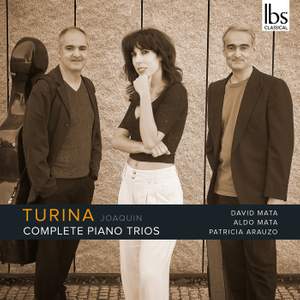
Joaquin Turina (1882-1949)
Complete Piano Trios
Piano Trio in F major (1904)
Circulo, Op 91
Piano Trio No 1 in D major, Op 35 (1926)
Piano Trio No 2 in B minor, Op 76 (1933)
David Mata (violin), Aldo Mata (cello), Patricia Arauzo (piano)
rec. 2021, Auditorio Manuel de Falla, Granada, Spain
IBS Classical IBS192022 [69]
In 2001, Naxos brought out a recording of Turina’s complete music for Piano Trio, played by the Spanish group Trio Arbós (review). I had thought that they could not be surpassed, but this disc, also played by Spaniards who must know Turina’s language, convinced me otherwise.
Trio in F major, a student work, is a highly competent four-movement piece. Cellist Aldo Mata’s booklet names two influences. Turina heard, and was affected by, Tchaikovsky’s 5th Symphony when it played in Madrid in 1902. And he owes the cyclic form to César Franck through Vincent d’Indy, Turina’s teacher and Franck’s pupil and biographer. The Lento introduction to the first movement and some of the ideas from the ensuing Allegro find their way into the finale. The lyricism of the second Andante movement also emerges, in part at least, in the finale. The Allegro alla danza (interestingly in 5/4 time) makes a brief relaxing appearance before the finale, which begins Andante grandioso and moves through Prestissimo and Cantabile back to Andante. This full-bloodied romantic essay presaged worthy things to come.
Piano Trio No 1 is full of the sounds and smells of Spain, especially the Theme and Variations middle movement. Various local dance styles, employed for each variant with attractive rhythms, remind us of a warm Spanish evening and of music from a distant café. The third movement, Sonate, moves effortlessly between compound duple and simple triple time. It ends with, as the booklet says, “extreme brilliance and the most extraverted Andalusian jolgorio”. The first movement Prelude and Fugue begins more seriously on the two string instruments, and this material makes an appearance in the third movement. All told, the mood is never oppressive and casts a spell of delight and contentment.
Piano Trio No 2 readily mixes a broad European romanticism (as in the first subject of the first movement) with what gets called folkloristic elements: syncopated, gentle dance rhythms. The dreamy second subject of this movement briefly reappears, melodically, in the central section of the 5/8 Scherzo which forms the work’s central panel. The finale ends with a passionate, rather French Allegretto, preceded by a calm and beautiful Andante mosso. It is a compact and evocative piece, one to return to and enjoy.
Turina’s farewell to the form, Circulo, was first heard in 1942. It is unique in going through a description of the day in its three connected movements (separately tracked): Amancer, Mediodia and Twilight. Here is what the booklet essay suggests: you are taken on a journey through Andalucía with the plucking of guitars (here played pizzicato), impressionistic crepuscular harmonies and even the call of bulls. For once, I prefer the longer Naxos version, which spreads its wings a little more.
All in all, I like the performance and the sound. I am grateful for the very useful booklet essay, never mind the somewhat unidiomatic English. There are photos of the performers taken from various unusual angles.
Gary Higginson
Help us financially by purchasing from




















